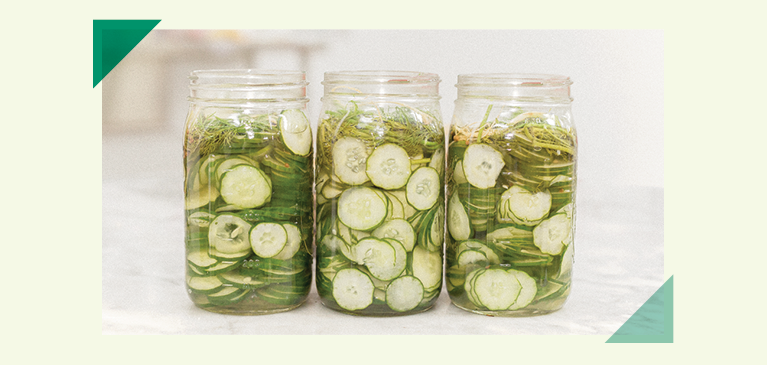
Bountiful harvests are underway! Fresh produce is great to have in the summertime, but it always seems to turn before we have time to get to all of it. Processing some of the fresh produce can help extend its life and allow you to enjoy fresh tasting produce year-round. Start with finding a pickle recipe you like, whether it’s bread and butter or dill – these tips and tricks are sure to help you prepare the perfect pickles!
1. Avoid using supermarket produce, using fresh local produce is always preferred. Some supermarket produce has a waxy covering to preserve shelf life which can affect your results.
2. Select or cut produce to be uniform in shape. When preparing a batch, it’s important they are all roughly the same shape and size. This way they take the same amount of time to pickle.
3. For crisper produce, spread the produce into a wide bowl and add a layer of pickling salt on top. Cover and let sit overnight in a cool place. Take out the liquid, rinse and dry your produce before pickling like normal. The salt pulls extra moisture out for a crunchy bite.
4. Let your brine cool down completely before adding it to the vegetables. Some vegetables can cook and become soft when a hot brine is poured over top of them. It is important to warm the brine so the salt and spices can dissolve, but cooling it will help keep everything as crisp as possible.
5. Take care of your jars! It’s important to sterilize your jars before you start to ensure proper conditions. After filling, wiping the rim of the jar with vinegar will help achieve a tight seal. Instead of placing the cold jars directly into the boiling water for proper processing, place the jars in first, fill with water, and then raise to a boil. This allows the cans to acclimate to the temperature, making it less likely for them to shatter while still ensuring a good seal.
6. Label and date your jars. When pickling different types of vegetables, it’s important to date them to make sure they have proper processing times. Every vegetable takes a different amount of time to pickle so having dates recorded can help ensure you get the perfect pickled product!
7. Store in a cool, dry, and dark place. This could be a pantry, cabinet, or basement. Storing in a warm spot increases the likeliness of mold and yeast growth which can spoil the batch. It can also lead to excessive pressure in the jar, potentially bulging the lid – or worse, breaking the jar. When properly stored, they can stay more crisp and maintain their fresh-tasting flavor.
To view the summer 2025 issue of Partners magazine in its entirety, click here.


